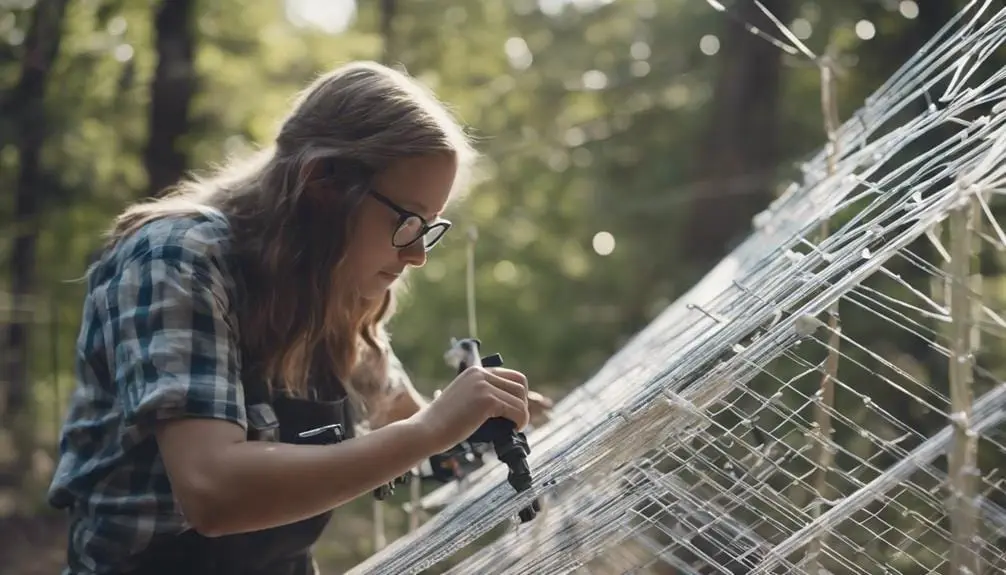The Best Fluffy Pancakes recipe you will fall in love with. Full of tips and tricks to help you make the best pancakes.

Are you looking to give your feline friend a safe outdoor space to explore? Building a PVC Pipe Cat Enclosure may be just the solution you need.
With just a few simple steps, you can create a secure and enjoyable environment for your cat to experience the outdoors.
Stay tuned to discover how you can easily construct this DIY project and provide your cat with a space they'll love.
Key Takeaways
- Plan carefully for dimensions and cat preferences to build a suitable PVC pipe cat enclosure.
- Enhance comfort and safety with perches, toys, and a secure roof for your cats' enjoyment.
- Create a stimulating environment with climbing structures, hiding spots, and engaging toys.
- Maintain regularly for safety, offer shade, and ensure easy access with a cat door for enjoyment.
Planning Your PVC Pipe Cat Enclosure
When planning your PVC pipe cat enclosure, consider the available space and your cats' climbing habits to determine the dimensions and layout for optimal construction. Measure the outdoor area where you intend to build the enclosure, ensuring it ranges between 2 to 8 feet in each direction to accommodate the structure. Take into account your cats' love for climbing by planning the height, width, and depth of the enclosure accordingly.
For the DIY project, gather the necessary materials such as PVC pipes, fittings, plywood, and hardware to ensure stability and durability. Calculate the layout, envisioning a main cube design with bracing every 2 feet to support the structure. Include a 2-foot wide doorway for easy access in and out of the enclosure. By acquiring all materials beforehand, including hardware cloth for added safety, you can streamline the construction process and ensure a seamless building experience.
Planning meticulously based on space availability and your cats' behaviors will result in a functional and enjoyable outdoor haven for your feline companions.
Constructing the PVC Pipe Frame
To begin constructing the PVC pipe frame for your cat enclosure, gather the required PVC pipes, connectors, and tools in preparation for assembly. When building the PVC frame for your DIY cat enclosure, follow these steps:
- Measure Twice, Cut Once: Use a measuring tape to ensure accurate dimensions for your PVC frame. Precise measurements will help you create a sturdy and well-fitted structure for your PVC cat enclosure.
- Secure Connections with PVC Connectors: Utilize PVC pipe connectors to join the PVC pipes securely. These connectors play a vital role in maintaining the stability and durability of your PVC Catio frame.
- Consider Cat Access Points: Plan for a cat door within the PVC frame to allow your feline friend easy access to the outdoor space. Incorporating this feature during the construction phase will make the PVC cat enclosure more functional and enjoyable for your pet.
Adding Finishing Touches and Safety Features
Consider incorporating perches and shelves inside the catio using PVC connectors to enhance stability and comfort for your cats. These additions provide your feline friends with elevated spaces to relax and observe their surroundings.
Enhance the catio's interior with soft rugs, engaging toys, and decorative elements to create a cozy and stimulating environment for your cats. Installing a roof over the enclosure offers shade and protection from the elements, ensuring your cats can enjoy the outdoors safely.
Personalize the catio by customizing features such as hiding spots or climbing structures to cater to your cats' preferences and behaviors. Prioritize safety by securely fastening the netting to prevent any potential escapes and regularly inspecting the enclosure for safety hazards.
Frequently Asked Questions
How to Build a Catio With PVC Pipe?
To build a catio with PVC pipe, design a versatile structure for outdoor play. Ensure feline safety with window access, climbing shelves, and mesh screening. Customize sizing, consider sunlight exposure, and enrich your cat's environment with this DIY project.
What Is the Cheapest Way to Build a Catio?
For a budget-friendly catio, consider DIY solutions with PVC pipes. These affordable materials offer creative designs, customizable features, and easy assembly. Opt for weather-resistant options, space-saving ideas, and low-maintenance designs for a portable and cost-effective outdoor cat enclosure.
What Is the Best Material for a Cat Enclosure?
For the best cat enclosure, consider a combination of materials like metal mesh for security, a wooden frame for durability, vinyl siding for weather resistance, and wire mesh for ventilation. These elements create a safe and comfortable space for your feline friend.
What Are the Requirements for a Cat Enclosure?
For outdoor safety, consider cat behavior when planning DIY projects like a cat enclosure. Include cat enrichment with climbing structures and outdoor play areas. Use PVC pipe sizes for sturdy frames, cat proofing, and areas for outdoor exploration to promote cat health.
Conclusion
In conclusion, building a PVC pipe cat enclosure in 3 easy steps is a great way to provide a safe and enjoyable outdoor space for your feline friends.
By carefully planning the layout, constructing a sturdy frame, and adding finishing touches like walls and netting, you can create a catio that will keep your cats entertained and protected.
Remember to consider your cats' needs and preferences when designing and building their new outdoor haven.








